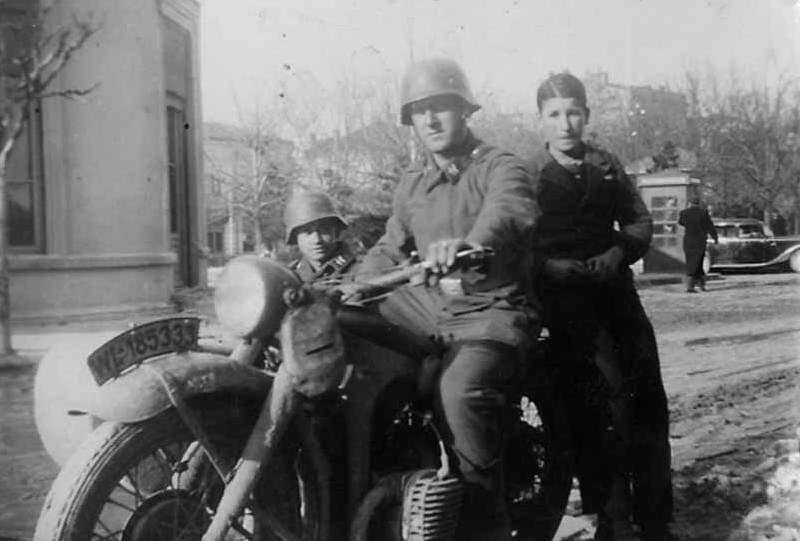
Bulgaria Joins the Axis: German Troop Movements (March 1941)

Figure 1.--German soldier took lrge numbers of persinal photiographs during Wirkd War II. This German snapshot shows two German Lutwaffee airmem with a BMW R75 motorcycle and a Bulgarian boy, photographed in Sofia, we think during late-1941. We have no idea about the relationship, but the boy seems friendly with them.
|
|
With accession to the Axis, German military units poured moved into Bulgaria, putting them in a position to move against northern Greece and southern Yugoslavia. At the time, Italy's misguided invasion had pushed Greece toward the British which brought the Ploesti oilfiels within in range of British bombers. When Bulgarian joined the Axis (March 1), the Whermacht was ready to act. The task was given to the 12th Army. The Whermact had activated the 12th Army (October 1939) under the command of General Wilhelm List. It was deployed in adefensive position along the Siegfried Line and then participated in the invasion and occupation of France. Afterwards, the Army was shifted east as part of the German buildup in the East. It was moved into Romania when that country joined the Axis (November 1940). The 12th Army begun assembling a sizeable force in southern Romania. We do not yet have precise details, but some 24 divisions may have been preopared to enter Bulgaria. Field Marshal List and the Bulgarian General Staff prepared for Bulgarian accension to the Axis, negotiated an agreemet allowing for the passage of German troops. German Army units crossed the Danube from Romania and took up strategic positions in Bulgaria (February 28). The plan was not to occupy Bulgaria. It was believed that Bulgarian woud be brought into the Axis diplomatically. The goal was was Greece which was fighing with Axis partner Italy. The ininital plan was to occupy the northern coast of the Aegean Sea and possibly the entire Greek mainland. he Luftwaffe was-to provide air protection during the assembly period and prepare bases in Romania. During the operation the Luftwaffe was to neutralize Greek and British air forces, support the ground forces, and prepare for airborn assults on British bases. It was at first believed that the Yugoslavs would also join the Axis. When this fell through, the German troops in Bulgaria were reposition to attack west into Yugoslavia. The German troops entering Bulgaria experienced agenerally warm welcome. There were reports that many villagers met the advance elements of the 12th Army with the traditional bread and salt ceremony. [Miller, p. 46.] Both the German and Bulgarian Governments were somewhat surprised with the warmth of the welcome. We are not sure just what was involved here, but it may have been at least partly because of World War I relationship as allies. Filov claimed this was a kind of plebecite showing support for his policies. Some historians believe it reflected the NAZI-Soviet alliance and saw it as a kind of sign that there would not be another war.
After the victory over Yugoslavia and the Greeks, most the German troops were rapidly pulled out of Bulgaria, for both occupation duty and for assembly positions in Romania preparing for Barbarossa. The 12th Army would be the principal German formation in the Balkans.
Sources
Miller, Marshall Lee. Bulgaria during the Second World War.
HBC

Navigate the Boys' Historical Clothing Web Site:
[Return to Main Bulgaria joins the Axis page ]
[Return to Main World War II Bulgaria page ]
[Return to Main World War II country page ]
[Return to Main Balkan Axis page]
[Biographies]
[Campaigns]
[Children]
[Countries]
[Deciding factors]
[Diplomacy]
[Geo-political crisis]
[Economics]
[Home front]
[Intelligence]
[POWs]
[Resistance]
[Race]
[Refugees]
[Technology]
[Bibliographies]
[Contributions]
[FAQs]
[Images]
[Links]
[Registration]
[Tools]
[Return to Main World War II page]
[Return to Main war essay page]
Created: 5:46 AM 2/11/2013
Last updated: 5:46 AM 2/11/2013



